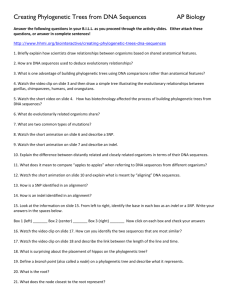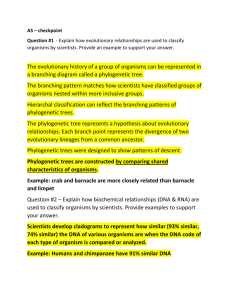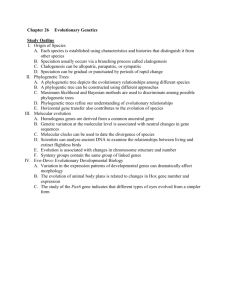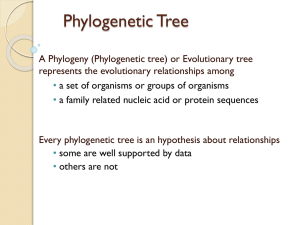Origin of Species - Indiana University
advertisement
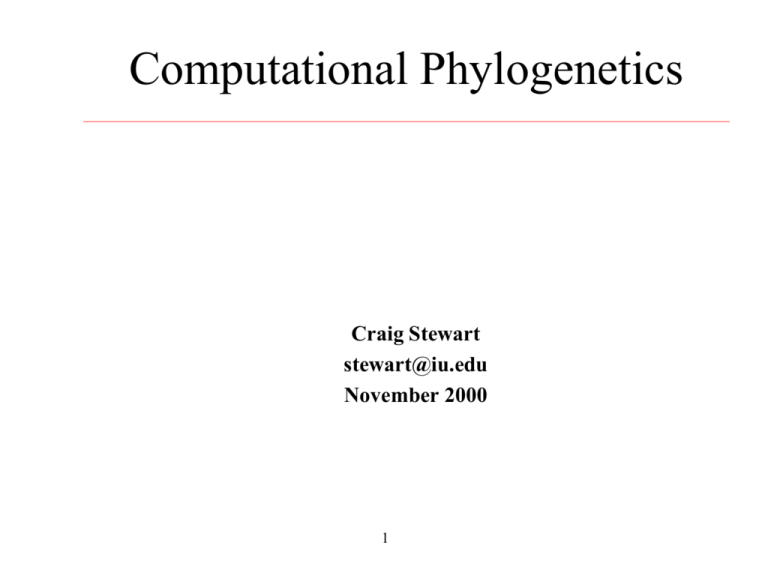
Computational Phylogenetics Craig Stewart stewart@iu.edu November 2000 1 License info • • Please cite as: Stewart, C.A. 2000. Computational Biology. (Tutorial presentation) IEEE/ACM SC01 Conference (Dallas, TX, Nov 2000). Available from: http://hdl.handle.net/2022/14007 (Presented as part of tutorial Zorn, M., S. Spengler, I. Dubchack, H. Simon, C.A. Stewart. 2000. Computational Biology and High Performance Computing) Except where otherwise noted, the contents of this presentation are © by the Trustees of Indiana University. This content is released under the Creative Commons Attribution 3.0 Unported license (http://creativecommons.org/licenses/by/3.0/). This license includes the following terms: You are free to share – to copy, distribute and transmit the work and to remix – to adapt the work under the following conditions: attribution – you must attribute the work in the manner specified by the author or licensor (but not in any way that suggests that they endorse you or your use of the work). For any reuse or distribution, you must make clear to others the license terms of this work. 2 Outline • • • • • Evolution & Phylogenetics Why is this a HPC problem Alignment (brief) Summary of methods and software for phylogenetics One example in detail: Maximum Likelihood analysis with fastDNAml • Some interesting results and challenges for the future • Caveat: this is an introduction, not an exhaustive review. 3 Phylogeny • Evolution is an explicitly historical branch of biology, one in which the subjects are active players in the historical changes. • A phylogeny, or phylogenetic tree, is a way of depicting evolutionary relationships among organisms, genes, or gene products. • Modern evolutionary theory began with Darwin’s Origin of Species, which included one figure – an evolutionary tree 4 Origin of Species, Figure 1 5 Building Phylogenetic Trees • Goal: an objective means by which phylogenetic trees can be estimated in tolerable amounts of wall-clock time, producing phylogenetic trees with measures of their uncertainty 6 Basic Evolutionary Biology • All evolutionary changes are described as bifurcating trees - evolutionary relationships among genes or gene products (trees of paralogues) -evolutionary relationships among organisms (trees of orthologues) 7 Why • Curiosity: Anyone who as a child wandered through the dinosaur section of a natural history museum understands the inherent intellectual attraction of evolutionary biology • Theoretical uses: testing hypotheses in evolutionary biology • Practical uses: – Medicine – Environmental management (biodiversity maintenance) 8 Reconstructing history from DNA sequences • DNA changes over time; much of this change is not expressed • Changes in unexpressed DNA can be modeled as Markov processes • By comparing similar regions of DNA from different organisms (or different genes) one can infer the phylogenetic tree and evolutionary history that seems the best explanation of the current situation 9 DNA replication Purines: Pyrimidines: Adenine & Guanine Thymine & Cytosine 10 Changes in genetic information over time • Point mutations DNA – sequences of the 4 nucleotides CCTCTGAC vs TCTCCGAC Protein – sequences of the 20 amino acids GSAQVKGHGKK vs GNPKVKAHGKK • Insertions and deletions DNA CCTCT+GAC vs CCTCTTGAC 11 Sequences available • DNA (sequences are series of the base molecules; aligned sequences will also contain +s for gaps) • Amino acid sequences (series of letters indicating the 20 amino acids). Computational challenges more severe than with DNA sequences. • RNA • The availability of data at present exceeds the ability of researchers to analyze it! 12 Why is tree-building a HPC problem? • The number of bifurcating unrooted trees for n taxa is (2n-5)!/ (n-3)! 2n-3 • for 50 taxa the number of possible trees is ~1074; most scientists are interested in much larger problems • The number of rooted trees is (2n-5)! 13 Alignment • To build trees one compares and relates ‘similar’ segments of genetic data. Getting ‘similar’ right is absolutely critical! • Methods: – dynamic programming – Hidden Markov Models – Pattern matching • Some alignment packages: – BLAST (http://www.ncbi.nlm.nih.gov/BLAST/) – FASTA (http://gcg.nhri.org.tw/fasta.html) – MUSCA (http://www.research.ibm.com/bioinformatics/home) 14 Matching cost function GCTAAATTC ++ x x GC AAGTT • Penalize for mismatches, for opening of gap, and for gap length • This approach assumes independence of loci: good assumption for DNA, some problems with respect to amino acids, significant problems with RNA 15 Example of aligned sequences Thermotoga ATTTGCCCCA GAAATTAAAG CAAAAACCCC AGTAAGTTGG GGATGGCAAA Tthermophi ATTTGCCCCA GGGGTTCCCG CAAAAACCCC AGTAAGTTGG GGATGGCAGG Taquaticus ATTTGCCCCA GGGGTTCCCG CAAAAACCCC AGTAAGTTGG GGATGGCAGG G deinon ATTTGCCCCA GGGATTCCCG CAAAAACCCC AGTAAGTTGG GGATGGCAGG G Chlamydi ATTTTCCCCA GAAATTCCCG AAAAAACCCC AATAAATTGG GGATGGCAGG flexistips ATTTTCCCCA CAAAAAAAAG AAAAAACCCC AGTAAGTTGG GGATGGCAGG borrelia-b ATTTGCCCCA GAAGTTAAAG CAAAAACCCC AATAAGTTGG GGATGGCAGG bacteroide ATTTGCCCCA GAAATTCCCG CAAAAACCCC AGTAAATTGG GGATGGCAGG GG Pseudom ATTTGCCCCA GGGATTCCCG CAAAAACCCC AGTAAGTTGG GGATGGCAGG G ecoli----GTTTTCCCCA GAAATTCCCG CAAAAACCCC AGTAAGTTGG GGATGGCAGG salmonella ++++++++++++++++++++++++++++++++++++++++++++++++++++++++++++++ shewanella GTTTGCCCCA GCCATTCCCG TAAAAACCCC AGTAAGTTGG GGATGGCAGG bacillus-- ATTTGCCCCA GAAATTCCCG CAAAAACCCC AGCAAATTGG GGATGGCAGG G myco-gentl ATTTGCCCCG GAAATTCCCG CAAAAACCCC AGTAAGTTGG GGATGGCAAA 16 Phylogenetic methodologies • Define a specific series of steps to produce the ‘best’ tree – Pair-group cluster analyses – Fast, but tend not to address underlying evolutionary mechanisms • Define criteria for comparing different trees and judging which is better. Two steps: – Define the objective function (evolutionary biology) – Generate and compare trees (computation) • All of the techniques described produce an unrooted tree. • The trees produced likewise describe relationships among extant taxa, not the progress of evolution over time. 17 Distance-based Tree-building methods • Aligned sequences are compared, and analysis is based on the differences between sequences, rather than the original sequence data. • Less computationally intensive than character-based methods • Tend to be problematic when sequences are highly divergent 18 Distance-based Tree building methods, 2 • Cluster analysis. Most common variant is Unweighted Pair Group Method with Arithmetic Mean (UPGMA) – join two closest neighbors, average pair, keep going. Problematic when highly diverged sequences are involved • Additive tree methods – built on assumption that the lengths of branches can be summed to create some measure of overall evolution. – Fitch-Margoliash (FM) – minimizes squared deviation between observed data and inferred tree. – Minimum evolution (ME) – finds shortest tree consistent with data • Of the distance methods, ME is the most widely implemented in computer programs 19 Character-based methods • Use character data (actual sequences) rather than distance data • Maximum parsimony. Creates shortest tree – one with fewest changes. Inter-site rate heterogeneity creates difficulties for this approach. • Maximum likelihood. Searches for the evolutionary model that has the highest likelihood value given the data. In simulation studies ML tends to outperform others, but is also computationally intensive. 20 Rooting trees • If the assumption of a constant molecular clock holds, then the root is the midpoint of the longest span across the tree. • Sometimes done by including an ‘outgroup’ in the analysis • Remember that the trees produced from sequence data are fundamentally different than a historical evolutionary tree 21 Evaluating trees • Once a phylogenetic tree has been produced by some means, how do you test whether or not the tree represents evolutionary change, or just the results of a mathematical technique applied to a set of random data? These methods below can be used to perform a statistical significance test. • Significance tests for MP trees: – Skewness tests. MP tree lengths produced from random data should be symmetric; tree lengths produced from data sets with real signal should be skewed. • Significance tests for distance, MP, and ML trees: – Bootstrap. Recalculate trees using multiple samples from same data with resampling. – Jackknife. Recalculate trees using subsampling • All of these methods are topics of active debate 22 Phylogenetic software • Phylip. (J. Felsenstein). Collection of software packages that cover most types of analysis. One of the most popular software collections. Free. • PAUP. (D. Swofford). Parsimony, distance, and ML methods. Also one of the most popular software collections. Not free, but not expensive. • PAML. (Ziheng Yang). Maximum likelihood methods for DNA and proteins. Not as well suited for tree searching, but performs several analyses not generally available. Free. • fastDNAml. (G. Olsen). Maximum likelihood method for DNA; becoming one of the more popular ML packages. MPI version available soon; well suited to tree searching in large data sets. Free. 23 More on Maximum Likelihood methods • Typical statistical inference: calculate probability of data given the hypothesis • Tree, branch lengths, and associated likelihood values all calculated from the data. • Likelihood values used to compare trees and determine which is best 24 Stochastic change of DNA • Markov process, independent for each site: 4 x 4 matrix for DNA, 20 x 20 for amino acids A C G T A p(A->A) p(A->C) p(A->G) … C p(C->A) p(C->C) p(C->G) … G . T . • Transitions more probable than transversions. • Must account for heterogeneity in substitution rates among sites (DNArates – Olsen) 25 fastDNAml • • • • Developed by Gary Olsen Derived from Felsensteins’s PHYLIP programs One of the more commonly used ML methods The first phylogenetic software implemented in a parallel program (at Argonne National Laboratory, using P4 libraries) • Olsen, G.J.,et al.1994. fastDNAml: a tool for construction of phylogenetic trees of DNA sequences using maximum likelihood. Computer Applications in Biosciences 10: 4148 • MPI version produced in collaboration with Indiana University will be available soon 26 fastDNAml algorithm • Compute the optimal tree for three taxa (chosen randomly) - only one topology possible • Randomly pick another taxon, and consider each of the 2i5 trees possible by adding this taxon into the first, threetaxa tree. • Keep the best (maximum likelihood tree) • Local branch rearrangement: move any subtree to a neighboring branch (2i-6 possibilities) • Keep best resulting tree • Repeat this step until local swapping no longer improves likelihood value 27 Local branch rearrangement diagram 28 fastDNAml algorithm con’t: Iterate • • • • • • • Get sequence data for next taxon Add new taxa (2i-5) Keep best Local rearrangements (2i-6) Keep best Keep going…. When all taxa have been added, perform a full tree check 29 Overview of parallel program flow 30 Because of local effects…. • Where you end up sometimes depends on where you start • This process searches a huge space of possible trees, and is thus dependent upon the randomly selected initial taxa • Can get stuck in local optimum, rather than global • Must do multiple runs with different randomizations of taxon entry order, and compare the results • Similar trees and likelihood values provide some confidence, but still the space of all possible trees has not been searched extensively 31 32 33 Performance of fastDNAml 3500 3000 Wall clock time (seconds) 2500 2000 IU Only IU&NUS IU&ANU 1500 1000 500 0 0 2 4 6 8 10 # Processors 34 12 14 16 18 Applications & Interesting examples • Better understanding of evolution (Ceolocanths, cyanobacterial origin of plastids) • Maintenance of biodiversity • Medicine & molecular biology – our cousins, the fungi – Cytoplasmic coat proteins – HIV 35 Cytoplasmic Coat Proteins 36 HIV • Where did HIV come from, and how recent is it? • Korber, et al. 2000. Timing the ancestor of the HIV-1 pandemic strains. Science 288:1789. (Online at www.sciencemag.org/cgi/content/full/288/5472/1789) • Used completed HIV sequences from 159 individuals with known sampling dates (including one from 1959) • Used a general-reversible (REV) base substitution model, accounting for different site-specific rates of evolution and base frequencies biased in favor of adenosine. Used modified version of fastDNAml. • Used SIV as an outgroup • Last common ancestor of main group of HIV-1 was 1931 (95% confidence interval: 1915-1941). Supports hypothesis that HIV has been around for some time and simply took a while to be common enough to be noticed. 37 Challenges for future • HPC implementations of more phylogenetic techniques • Better treatment of insertions and deletions (indels) • Algorithms for more thorough searching of treespaces in incremental tree building processes (keep best n trees and keep looking) • Techniques for not shaking the whole tree (that is, adding a taxa to a tree in a fashion that acknowledges damping of effect as you travel away from altered part of tree) • Use of high-throughput techniques 38 Acknowledgements • Some of the tree diagrams were adapted from Olsen et al. 1994. • Les Teach [IU] created all other graphics for this talk • IU’s work on parallel versions of fastDNAml has been facilitated by Shared University Research grants from IBM, Inc. • IU’s work with fastDNAml would be impossible without our collaboration with Gary Olsen, U. of Illinois, the creator of this program. 39 References • Felsenstein, J. 1981. Evolutionary trees from DNA sequences: a maximum likelihood approach. Journal of Molecular Evolution 17:368-376 • Baxevanis, A.D., and B.F.F. Ouellette. 1998. Bioinformatics: a practical guide to the analysis of genes and proteins.WileyInterscience, NY. • Swofford, D.L., and G.J. Olsen. Phylogeny reconstruction. pp. 411501 IN D.M. Nillis & C. Mority (eds). Molecular systematics. Sinauer Associates, Sunderland, MA. • Durbin, R. et al. 1998. Biological sequence analysis. Cambridge University Press, Cambridge, UK. • www.ucmp.berkely.edu/subway/phylogen • evolution.genetics.washington.edu/phylip/software • http://www.indiana.edu/uits/~rac 40 urls for phylogenetic software • Phylip. evolution.genetics.washington.edu/phylip/software.html • PAUP. www.lms.si.edu/PAUP/index.html • PAML. abacus.gene.ucl.ac.uk/software/paml.html • fastDNAml. geta.life.uiuc.edu/~gary/ 41

